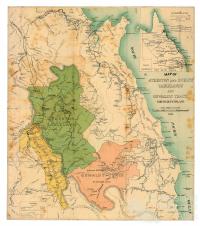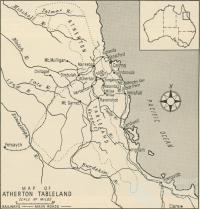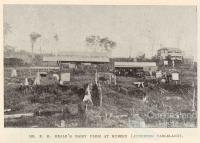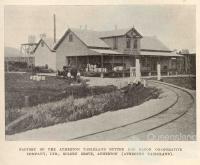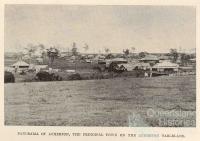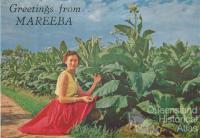- Home
- Quintessential Queensland
- Distinctiveness
- Perceptions
- Perceptions: how people understand the landscape
- From runs to closer settlement
- Geological survey of Queensland
- Mapping a new colony, 1860-80
- Mapping the Torres Strait: from TI to Magani Malu and Zenadh Kes
- Order in Paradise: a colonial gold field
- Queensland atlas, 1865
- Queensland mapping since 1900
- Queensland: the slogan state
- Rainforests of North Queensland
- Walkabout
- Queenslanders
- Queenslanders: people in the landscape
- Aboriginal heroes: episodes in the colonial landscape
- Australian South Sea Islanders
- Cane fields and solidarity in the multiethnic north
- Chinatowns
- Colonial immigration to Queensland
- Greek Cafés in the landscape of Queensland
- Hispanics and human rights in Queensland’s public spaces
- Italians in north Queensland
- Lebanese in rural Queensland
- Queensland clothing
- Queensland for ‘the best kind of population, primary producers’
- Too remote, too primitive and too expensive: Scandinavian settlers in colonial Queensland
- Distance
- Movement
- Movement: how people move through the landscape
- Air travel in Queensland
- Bicycling through Brisbane, 1896
- Cobb & Co
- Journey to Hayman Island, 1938
- Law and story-strings
- Mobile kids: children’s explorations of Cherbourg
- Movable heritage of North Queensland
- Passages to India: military linkages with Queensland
- The Queen in Queensland, 1954
- Transient Chinese in colonial Queensland
- Travelling times by rail
- Pathways
- Pathways: how things move through the landscape and where they are made
- Aboriginal dreaming paths and trading ways
- Chinese traders in the nineteenth century
- Introducing the cane toad
- Pituri bag
- Press and the media
- Radio in Queensland
- Red Cross Society and World War I in Queensland
- The telephone in Queensland
- Where did the trams go?
- ‘A little bit of love for me and a murder for my old man’: the Queensland Bush Book Club
- Movement
- Division
- Separation
- Separation: divisions in the landscape
- Asylums in the landscape
- Brisbane River
- Changing landscape of radicalism
- Civil government boundaries
- Convict Brisbane
- Dividing Queensland - Pauline Hanson’s One Nation Party
- High water mark: the shifting electoral landscape 2001-12
- Hospitals in the landscape
- Indigenous health
- Palm Island
- Secession movements
- Separate spheres: gender and dress codes
- Separating land, separating culture
- Stone walls do a prison make: law on the landscape
- The 1967 Referendum – the State comes together?
- Utopian communities
- Whiteness in the tropics
- Conflict
- Conflict: how people contest the landscape
- A tale of two elections – One Nation and political protest
- Battle of Brisbane – Australian masculinity under threat
- Dangerous spaces - youth politics in Brisbane, 1960s-70s
- Fortress Queensland 1942-45
- Grassy hills: colonial defence and coastal forts
- Great Shearers’ Strike of 1891
- Iwasaki project
- Johannes Bjelke-Petersen: straddling a barbed wire fence
- Mount Etna: Queensland's longest environmental conflict
- Native Police
- Skyrail Cairns (Research notes)
- Staunch but conservative – the trade union movement in Rockhampton
- The Chinese question
- Thomas Wentworth Wills and Cullin-la-ringo Station
- Separation
- Dreaming
- Imagination
- Imagination: how people have imagined Queensland
- Brisbane River and Moreton Bay: Thomas Welsby
- Changing views of the Glasshouse Mountains
- Imagining Queensland in film and television production
- Jacaranda
- Literary mapping of Brisbane in the 1990s
- Looking at Mount Coot-tha
- Mapping the Macqueen farm
- Mapping the mythic: Hugh Sawrey's ‘outback’
- People’s Republic of Woodford
- Poinsettia city: Brisbane’s flower
- The Pineapple Girl
- The writers of Tamborine Mountain
- Vance and Nettie Palmer
- Memory
- Memory: how people remember the landscape
- Anna Wickham: the memory of a moment
- Berajondo and Mill Point: remembering place and landscape
- Cemeteries in the landscape
- Landscapes of memory: Tjapukai Dance Theatre and Laura Festival
- Monuments and memory: T.J. Byrnes and T.J. Ryan
- Out where the dead towns lie
- Queensland in miniature: the Brisbane Exhibition
- Roadside ++++ memorials
- Shipwrecks as graves
- The Dame in the tropics: Nellie Melba
- Tinnenburra
- Vanished heritage
- War memorials
- Curiosity
- Curiosity: knowledge through the landscape
- A playground for science: Great Barrier Reef
- Duboisia hopwoodii: a colonial curiosity
- Great Artesian Basin: water from deeper down
- In search of Landsborough
- James Cook’s hundred days in Queensland
- Mutual curiosity – Aboriginal people and explorers
- Queensland Acclimatisation Society
- Queensland’s own sea monster: a curious tale of loss and regret
- St Lucia: degrees of landscape
- Townsville’s Mount St John Zoo
- Imagination
- Development
- Exploitation
- Transformation
- Transformation: how the landscape has changed and been modified
- Cultivation
- Empire and agribusiness: the Australian Mercantile Land and Finance Company
- Gold
- Kill, cure, or strangle: Atherton Tablelands
- National parks in Queensland
- Pastoralism 1860s–1915
- Prickly pear
- Repurchasing estates: the transformation of Durundur
- Soil
- Sugar
- Sunshine Coast
- The Brigalow
- Walter Reid Cultural Centre, Rockhampton: back again
- Survival
- Survival: how the landscape impacts on people
- Brisbane floods: 1893 to the summer of sorrow
- City of the Damned: how the media embraced the Brisbane floods
- Depression era
- Did Clem Jones save Brisbane from flood?
- Droughts and floods and rail
- Missions and reserves
- Queensland British Food Corporation
- Rockhampton’s great flood of 1918
- Station homesteads
- Tropical cyclones
- Wreck of the Quetta
- Pleasure
- Pleasure: how people enjoy the landscape
- Bushwalking in Queensland
- Cherbourg that’s my home: celebrating landscape through song
- Creating rural attractions
- Festivals
- Queer pleasure: masculinity, male homosexuality and public space
- Railway refreshment rooms
- Regional cinema
- Schoolies week: a festival of misrule
- The sporting landscape
- Visiting the Great Barrier Reef
By:
Marjorie Gilmore The Atherton Tablelands consists of three tablelands, Hann in the north, Atherton, and Evelyn in the south. It is situated in North Queensland in the Cairns hinterland. After intense volcanic activity, dense rainforest was established on the southern tablelands approximately 50,000 years ago. For thousands of years they had been the home of Aboriginal people who moved over the landscape and through the forests with minimal impact. However, exploration and mineral discoveries followed by pastoralists and farmers transformed the area completely. Today, it is known for the beauty of savannah, remnants of rain forest, volcanic craters, lakes and waterfalls, and rolling hills as well as agriculture and animal production.
Land clearing
Maize was one of the first crops produced on the tablelands, grown for animal and human consumption. When the land around what is now the town of Atherton was opened for settlement in the 1880s, blocks were taken up by men many of whom had no experience as farmers. Confronted by impenetrable forest, stinging trees, leeches, snakes and unknown hazards, many opted to appoint Chinese as bailiffs to clear land and grow crops. Land was clear felled and timber not sold to loggers was burnt. Thousands of acres of rainforest, including valuable cabinet timbers, were destroyed as a direct result of land laws which required clearing and cultivation as a condition of occupancy. Over the following hundred years, most timber was cleared from vast areas of the southern tablelands to establish a variety of crops, of which the maize industry is now a significant sector.
By the turn of the nineteenth century Queensland governments were encouraging the establishment of dairy industries over many parts of the State. The tablelands were no exception, and land was taken up by dairy farmers and their herds to provide butter for home and export consumption. Again, a condition of occupancy was clearing and fencing of land, and thousands of acres of land, some on volcanic slopes, were cleared and planted with exotic grasses. However, distance from markets and lack of refrigeration and transport caused the industry to struggle for years until factories to process the milk and cream were built. In time, service towns were established and roads, schools, hospitals, courthouses and other infrastructure built for the growing population. Demands by American service personnel for fresh milk during World War II transformed the industry from butter to fresh milk production which brought a measure of prosperity to the farmers. Large scale soil conservation projects during the 1960s, as well as pasture improvement initiatives stabilised fragile soils, and led to greater efficiencies in both production and then processing of raw product. Dairy deregulation in the 1990s caused a contraction in the industry with many farms converting to grazing beef cattle or cropping. Over the past 100 years the dairy industry was a major contributor to the transformation of the southern tablelands from essentially rainforest to cultivated grasslands and animal production.
Tobacco and water
The third industry to have a major impact on the landscape was the tobacco industry, established at the northern end of the tablelands around the township of Mareeba in the early 1930s. Farms were established in the relatively dry savannah land which is mainly granitic in structure, considered ideal for tobacco cultivation. However, production of high quality leaf is notoriously difficult for dry land farmers, and it quickly became obvious that successful cultivation required irrigation. Therefore tobacco farms were established along natural water courses, but water supply was not consistent, and sometimes unpredictable. As the industry expanded it became clear that a reliable source of water was necessary. In 1955 Tinaroo Dam was completed, the only dam in Australia specifically constructed to service the needs of a single agricultural industry at that time. The source of water in the dam is the Barron River, rising on the southern part of the tablelands. Water is delivered to farms through hundreds of kilometres of concrete channels. More land was opened up for tobacco growing, and the industry expanded so quickly that it was necessary to control production through various Stabilisation Plans for the next thirty years, until eventual deregulation of the industry in the 1990s, after which tobacco growing ceased entirely and a range of horticultural and tree crops have taken its place.
During the course of the last one hundred and fifty years the Atherton Tablelands have been transformed from pristine rainforest and sclerophyl forest providing a home for possibly 1000 Aboriginal people living sustainably and non-intrusively within the landscape, to a food bowl supporting 60,000 people. The transformation has come at the cost of the destruction of hundreds of thousands of trees, loss of habitat for many rainforest species, both flora and fauna, and in places, soil degradation. World Heritage listing of remaining rain forest, soil conservation and plantings of wild-life corridors by farmers have gone some way to remedy the impact of food production on the landscape, and the Atherton Tablelands today is beautiful, but in no way similar to the way it was more than one hundred and fifty years ago.
References and Further reading (Note):
M.A. Gilmore, ‘Kill, cure or strangle, the history of government in three key agricultural industries on the Atherton Tablelands, 1895-2005, PhD thesis, James Cook University of North Queensland, 2005

